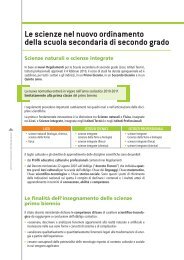Scarica un campione dell'opera in formato pdf
Scarica un campione dell'opera in formato pdf
Scarica un campione dell'opera in formato pdf
Create successful ePaper yourself
Turn your PDF publications into a flip-book with our unique Google optimized e-Paper software.
28<br />
B2<br />
4 figura 8<br />
La pendenza<br />
della l<strong>in</strong>ea retta<br />
sul diagramma<br />
spazio-tempo<br />
<strong>in</strong>dica la velocità<br />
del corpo.<br />
D Se l’auto<br />
<strong>in</strong> figura 8a<br />
impiegasse<br />
meno tempo<br />
per percorrere<br />
<strong>un</strong>a data distanza,<br />
come cambierebbe<br />
la pendenza<br />
della retta<br />
che rappresenta<br />
il suo moto?<br />
4 figura 9<br />
Il modulo<br />
della velocità<br />
di <strong>un</strong> ghepardo è<br />
di circa 90 km/h.<br />
È però necessario<br />
conoscere anche<br />
la direzione,<br />
per descrivere<br />
correttamente<br />
il moto.<br />
Velocità scalare e velocità vettoriale<br />
Spazio (metri)<br />
500<br />
400<br />
Velocità costante elevata<br />
300<br />
200<br />
250 m<br />
300<br />
200<br />
100<br />
0<br />
0 4<br />
10 s<br />
8 1216<br />
20<br />
100<br />
0<br />
0 4<br />
10 s<br />
8 12<br />
125 m<br />
16 20<br />
a Tempo (secondi) b<br />
Tempo (secondi)<br />
c<br />
Nella figura 8a l’automobile si muove per 500 m<br />
<strong>in</strong> 20 s: si può dire che si sta muovendo con <strong>un</strong>a<br />
velocità di 25 m/s. Nella figura 8b, <strong>un</strong>’altra automobile<br />
si muove a velocità costante, percorrendo<br />
250 m <strong>in</strong> 20 s: se si calcola la pendenza della retta<br />
250,0m<br />
si ottiene <strong>un</strong>a velocità vB = = 12, 5 m/s .<br />
20,0s<br />
500<br />
400<br />
La retta che descrive il moto dell’auto più veloce<br />
è più ripida.<br />
La figura 8c mostra il moto di <strong>un</strong>’automobile che non<br />
si muove a velocità costante. Essa percorre 200,0 m<br />
nei primi 8,0 s, qu<strong>in</strong>di si ferma per 4,0 s, come <strong>in</strong>dicato<br />
dalla l<strong>in</strong>ea orizzontale sul grafico, successivamente<br />
percorre 300,0 m <strong>in</strong> 8,0 s. La pendenza di ciasc<strong>un</strong><br />
tratto di l<strong>in</strong>ea retta rappresenta la velocità costante <strong>in</strong><br />
quel tratto. Nota che la velocità scalare dell’auto è di<br />
25 m/s nella prima parte e di 37,5 m/s nell’ultima<br />
parte del moto.<br />
3La velocità<br />
vettoriale<br />
Il ghepardo è l’animale più veloce della terra. Supponi<br />
che <strong>un</strong> ghepardo corra a 90 kilometri orari e che<br />
si trovi a 30 metri da <strong>un</strong>’antilope: <strong>in</strong> quanto tempo<br />
© Pearson Italia S.p.A. - Frank, Wysession, Yancopoulos<br />
Fisica - Concetti <strong>in</strong> azione<br />
Spazio (metri)<br />
Velocità costante bassa<br />
Spazio (metri)<br />
500<br />
400<br />
300<br />
Velocità variabile<br />
200<br />
100 100 m<br />
0<br />
0<br />
4s<br />
4 8 12 16 20<br />
Tempo (secondi)<br />
raggi<strong>un</strong>gerà la sua preda? Hai tutte le <strong>in</strong>formazioni<br />
per rispondere alla domanda? La risposta è no.<br />
Talvolta conoscere la velocità scalare di <strong>un</strong> corpo,<br />
cioè solamente il suo valore, non è sufficiente per<br />
descriverne il moto, perché è necessario conoscere<br />
anche la sua direzione e il suo verso. Si <strong>in</strong>troduce<br />
allora la velocità vettoriale, che è app<strong>un</strong>to <strong>un</strong><br />
vettore il cui modulo è il valore della velocità, e<br />
la direzione e il verso sono quelli del corpo <strong>in</strong><br />
movimento:<br />
La velocità vettoriale è <strong>un</strong> vettore che descrive<br />
sia il valore della velocità sia la direzione e il<br />
verso del moto.<br />
Se ti è capitato di vedere <strong>un</strong> documentario sui<br />
ghepardi, avrai notato come questi animali sono <strong>in</strong><br />
grado di cambiare rapidamente la loro velocità, sia<br />
<strong>in</strong> valore sia <strong>in</strong> direzione.<br />
Per rappresentare il moto di <strong>un</strong> ghepardo puoi<br />
qu<strong>in</strong>di utilizzare vettori di l<strong>un</strong>ghezza diversa, ciasc<strong>un</strong><br />
vettore corrispondente alla velocità dell’animale<br />
a <strong>un</strong> istante specifico. Un vettore più l<strong>un</strong>go<br />
rappresenterà <strong>un</strong>a velocità maggiore, <strong>un</strong>o più corto<br />
4s<br />
150 m







